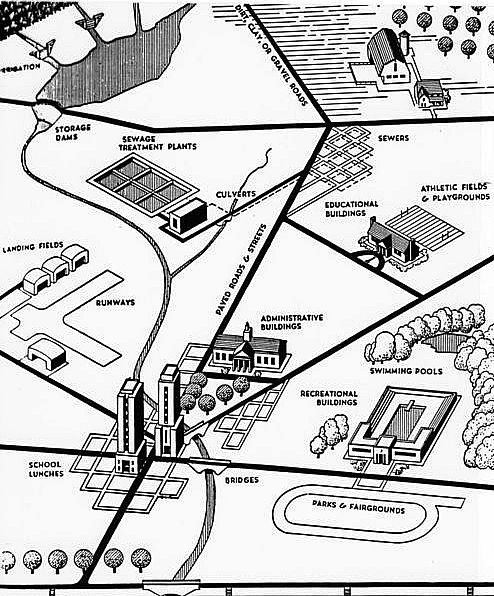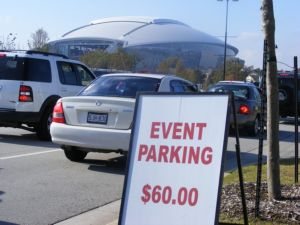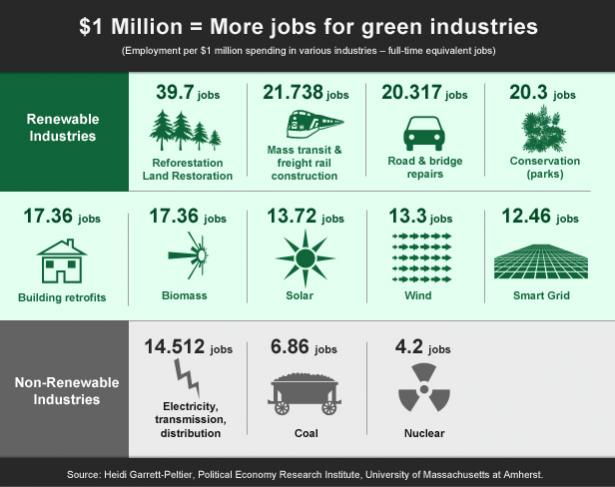 1940s WPA poster, showing various infrastructure projects that could benefit a community at the time || Unknown, WPA 1940s WPA poster, showing various infrastructure projects that could benefit a community at the time || Unknown, WPA |
Tom McNamara, Blueprint America
The Dallas Cowboys left town for a new stadium before the start of last year’s season. And the Dallas suburb of Irving, where the NFL team played from 1971 to 2008, is planning for life after football with a new transit-oriented development. At the same time, a new stadium just down the road has no transit access at all — except for a one-day, temporary rail line to be built for Super Bowl Sunday next year.
TRANSIT: ‘THE TALL T’ IN TEXAS
With a population around 200,000, Irving is a part of the North Texas Metroplex (nearly 7 million live there) — sprawl-land, U.S.A., to an outsider, but a part of the country that also has been building one of the most extensive mass-transit systems outside of the Northeast Corridor. That said, Texas was seen as the big loser when federal (stimulus) high-speed rail dollars were awarded earlier this year. It only received a $4 million grant for planning a project in the Dallas-Fort Worth area (with Irving in-between) as opposed to the hundreds of millions to even billions other states won.
When Texas Stadium is razed April 11, plans are already in place to redevelop the 80-acre site (with an additional 320-acres surrounding) located at the busy intersection of Texas highways 183 and 114, which about 150,000 cars pass through daily.
With new construction a least two years out, a city-contracted developer is looking for tenants in the meantime. And with the site’s proximity to the Dallas Area Rapid Transit light rail line to be installed next year, the area is primed for high density development — with plans for housing and condominium towers, a corporate or medical campus and an entertainment venue already in the works.
TEXAS TEA IS OIL, TOO
Older professional sports stadiums typically were built around highways and parking. Old Texas Stadium is a perfect example. But as the years went on, local mass-transit connected fans not wanting to pay big bucks for parking (or wanting to knock back a few drinks) to their teams. It happened in Irving and it happened in most sports-towns across the country. At the same time, almost all newly built stadiums now incorporate mass-transit, biking and walking (Target Field, the new Minnesota Twins stadium in Minneapolis, for example).
Cowboys owner Jerry Jones, however, built a $1.2 billion, 80,000-seat stadium 15 miles outside of Irving in the Dallas suburb of Arlington — the largest city in the country (population nearly 400,000) without a public transit system. The city recently tried a commuter bus system, but it met with little success. Arlington has even voted against tax increases several times in the last two decades that would have financed some form of public transit. Still, the city did increase the local sales-tax by a half cent in 2005 to pay for the new football stadium. On game day, as a result, area fans can spend hours in traffic and pay upwards of $60 for parking. And that’s just to get to the game — tickets to watch the game are even more expensive.
The lack of transit in the city can be seen in other ways, too. Rail connects Dallas to the east and Fort Worth to the west, but goes out of its way to avoid stopping in Arlington. And when the city hosts the Super Bowl next February, it will divert freight rail lines to set up a one-day rail stop — at a cost of $250,000 for a temporary public transit line, moving a projected 10,000 fans to the big game. The following day: Arlington will again be the largest city in the country without a public transit system.
San Diego Union-Tribune — Stimulus funds will help San Diego upgrade its infrastructure, including construction of a $565 million hospital at Camp Pendleton. Other major projects include $600 million to refurbish the Blue Line Trolley and about $1 billion to upgrade roads. [read more…]
 5,000 Characters [blog] — They say that the Oberstar was once a man. That perhaps, in constantly dealing with INFRASTRUCTURE! policy, he somehow hit critical mass that set off a chain reaction and turned him into a being of pure energy.
5,000 Characters [blog] — They say that the Oberstar was once a man. That perhaps, in constantly dealing with INFRASTRUCTURE! policy, he somehow hit critical mass that set off a chain reaction and turned him into a being of pure energy.
This, however, is unlikely. For as long as any sentient being has known, the Oberstar has always existed, deep in space, using his limitless source of energy to power transit and INFRASTRUCTURE! projects.
As alluded to in a previous post, the Oberstar will be critical to America’s next transportation bill. [read more…]
USA Today — Once the speed gauge hits 350 kilometers per hour, or 217 miles per hour, passengers charge down the aisle to photograph the electronic display.
“If we go any faster, we’ll take off!” jokes Hu Qing, cracking open another can of beer on China’s world-record-breaking train.
The Dec. 26 opening of the high-speed link between south Chinese cities Guangzhou and Wuhan is the latest example of massive state spending to keep China’s economy roaring. The fast-expanding network of high-speed trains is stoking patriotism, too.
“This train is the pride of the Chinese people,” says Hu, 42, the boss of a paper factory, who chose the train over a direct flight home to northeast China.
U.S. companies await the first round of government grants announced by President Obama in his State of the Union address totaling $8 billion to jump-start long-delayed high-speed rail in the USA.
Meanwhile, China enjoys a considerable head-start.
Last year, Beijing invested $88 billion in the country’s railways, according to the Ministry of Railways, and now operates a world-leading 1,758 miles of high-speed rail. [read more…]
Grist — With Congress and the White House considering spending scarce dollars to jump-start employment, they’ll need to get the biggest jobs bang for the buck to give Americans confidence that they’re spending our money wisely. Probably the biggest jobs generator of all, and one of the least recognized, is investing in forest and land restoration and sustainable management, with conservation, watershed projects, and park investment coming close behind. [read more…]
The Miami Herald — Construction of the new Marlins Stadium in Little Havana is moving ahead, with the project reaching an important step this week, officials from the baseball team said.
Already, workers have formed and placed track beams that will support the stadium’s retractable roof. The milestone: Workers are lifting the track beams into their permanent position, said Carolina Perrina, the team’s director of business communication.
The track beams will be placed above 12 super columns, which also support the roof.
So far, the Marlins and their contractor, Hunt/Moss, have built eight of the 12 super columns; four others are under construction, Perrina said.
The stadium is the first LEED-certified stadium with a retractable roof in the country, Edwin Perkins, a spokesman for Hunt/Moss, the Marlins’ contractor, recently told The Miami Herald. Located at 1501 NW Third St., the new stadium is supposed to be finished by 2012. [read more…]
Popular Science — In last night’s State of the Union address, President Obama talked a lot about the need to upgrade our country’s infrastructure, from power plants to railroads, both to create jobs and to improve efficiency. He wasn’t kidding: We lose an average of seven billion gallons of water a day to leaks in the system. Power interruptions cost the economy about $79 billion annually. And we all remember the Minneapolis bridge collapse, but up to a quarter of all the bridges in the country are in need of attention.
Fortunately, there are some amazing technologies already rolling out, and more just waiting for the funding the President talked about. We reached out to experts in transportation, telecommunications, sewage and water to figure out what kinds of technologies might be part of this next generation of infrastructure and found that the key isn’t patches, it’s an overhaul.
Smart systems that deliver only the power needed or recycle sewage for water and energy. Cantilevered trains could be built over existing roads. Roads could de-ice themselves. Here are 25 of those transformational technologies that might become reality sooner than later. [read more…]
The Mercury News (San Jose) — After years of trying and failing, the BART extension to San Jose has finally qualified for federal funds, with up to $900 million on the line.
The Federal Transit Administration included the BART project in its “new starts” program, in which transit agencies across the country compete for about $2 billion a year for new rail and bus lines, the Valley Transportation Authority confirmed Wednesday.
Federal funding would be the final piece in a complex financial puzzle, making it possible to bring the region’s most popular train line to the Bay Area’s biggest city. The state has committed $760 million for the effort, and Santa Clara County voters have approved two sales taxes to pay for building and operating the trains.
Sam Liccardo, a San Jose councilman and chairman of the VTA board, called the news a “significant milestone” that “shows that this project will compete well against other transit nationally.”
Thirty transit projects around the nation were in this year’s new starts pipeline, and 19 of those will get funding.
Even if the VTA does not get money next year, it will be in the running for federal dollars in following years. [read more…]
Star Tribune (Minneapolis) — Americans desperately need jobs. The nation’s sagging infrastructure badly needs repair and renewal. Why not put people to work fixing and building roads, bridges and transit systems? It all seemed a no-brainer.
But now comes the problem of money — or lack of it. A deficit projected at $1.35 trillion has made substantial borrowing for infrastructure renewal a fading dream. Many state governments lack the wherewithal to provide local matches for an aggressive federal initiative. And raising the user fee (federal gas tax) required to finance such a vast enterprise seems politically improbable as long as unemployment hovers in double digits.
U.S. Transportation Secretary Ray LaHood delivered that somber message in a visit to the Twin Cities this week. He made clear President Obama’s opposition to the nickel (or more) increase in the federal fuel tax needed to launch a significant transportation overhaul. “The president is just not going to be for that as long as people are hurting,” LaHood said.
Standing beside him, U.S. Rep. Jim Oberstar, chairman of the House transportation committee, acknowledged that his ambitious attempt to modernize the transport system is dead in the water. His bill has the support of 160 Democrats and 30 Republicans, but that’s still 28 votes short of passage and, with no help from the president on the fuel tax, the Minnesota Democrat’s hopes for a massive overhaul have dimmed considerably. [read more…]




